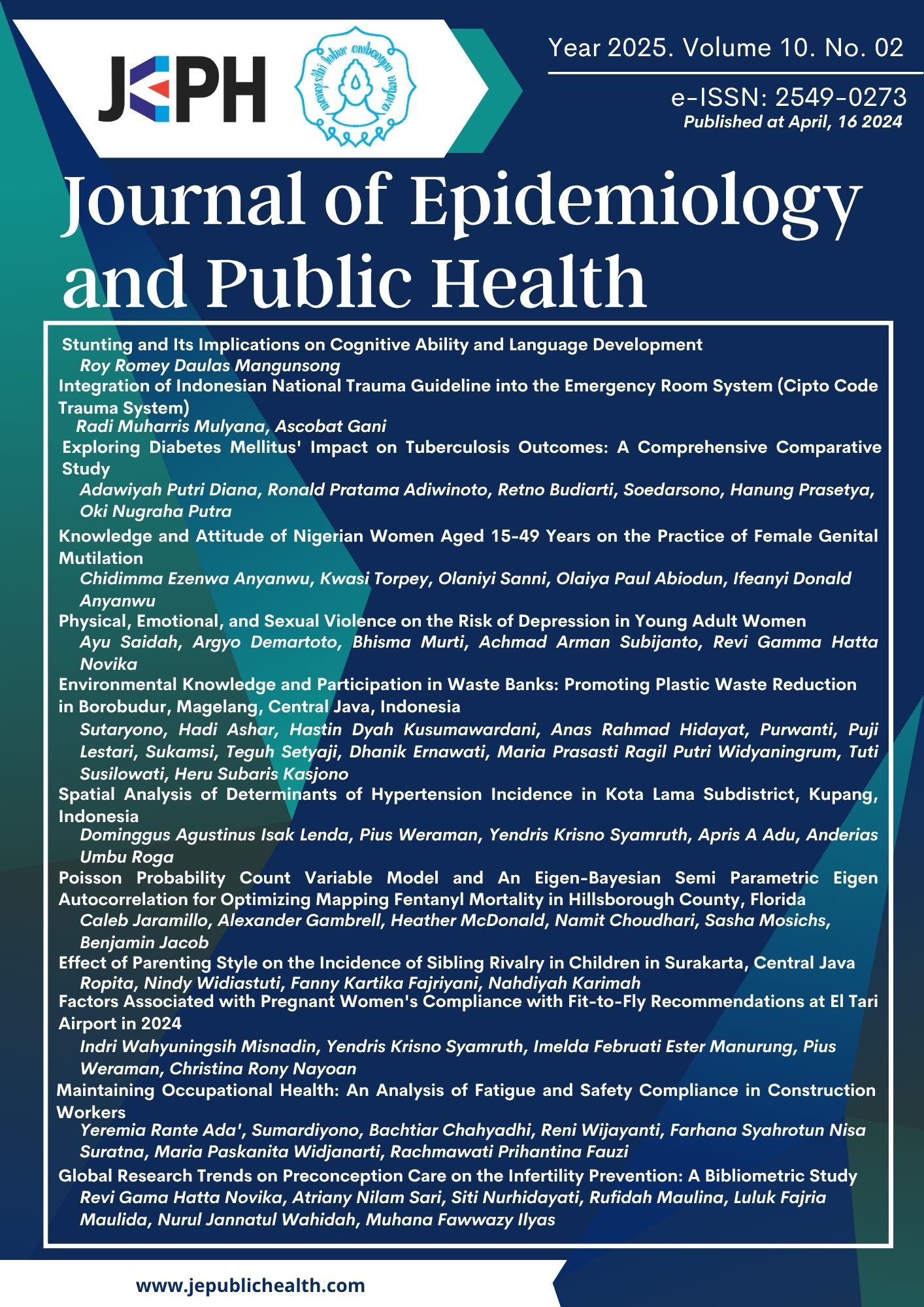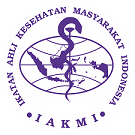Global Research Trends on Preconception Care on the Infertility Prevention: A Bibliometric Study
DOI:
https://doi.org/10.26911/jepublichealth.2025.10.02.12Abstract
Background: Infertility affects approximately one in six individuals globally and remains a growing reproductive health concern, often linked to modifiable risk factors present before conception. Preconception care (PCC) has gained recognition as a preventive strategy, however the implementation of PCC at scale remains challenged and yet its research landscape in relation to infertility remains under-mapped.This study aimed to analyze global research trends on preconception care in the context of infertility prevention using bibliometric methods.
Subjects and Method: A bibliometric analysis was conducted using the Scopus database, with data retrieved on May 12, 2024. The search strategy included terms related to PCC and infertility, yielding 486 eligible publications after screening. Included documents were English-language publications in final form, relevant to preconception care and infertility, and classified as articles, reviews, conference papers, or book materials. Analysis was performed using Scopus tools, Biblioshiny (R), and VOSviewer to examine publication trends, key contributors, and thematic evolution.
Results: A total of 486 publications from 1991 to 2025 were identified, with an annual growth rate of 6.43%. Most documents were original articles (67.7%) and reviews (28.4%), authored by 2,529 contributors across 307 publication sources. Several national strategies have formalized PCC into broader public health policy to reduce disparities in pregnancy outcomes and unmet fertility needs, but there remains a critical gap in the global PCC research agenda, such as the heterogeneity in intervention protocols.
Conclusion: Research on preconception care in the context of infertility prevention has expanded steadily. However, Future research should prioritize longitudinal and interventional studies, foster global collaboration, and align with broader reproductive justice goals to strengthen the evidence base. Ultimately, enhancing the visibility and implementation of PCC in both clinical and public health domains will be pivotal in addressing modifiable infertility risks and promoting equitable reproductive outcomes worldwide.
Keywords:
infertility, bibliometric analysis, scientific mapping, reproductive healthCorrespondence
Revi Gama Hatta Novika. Midwifery Study Program, Faculty of Medicine, Universitas Sebelas Maret,. Jl. Ir. Sutami 36 A, Kentingan, Jebres, Surakarta, Central Java, Indonesia. Email: revi.gama@staff.uns.ac.id.
References
ACOG (2024). Prepregnancy counseling. American College of Obstetricians and Gynecologists
Aria M, Cuccurullo C (2017). Bibliometrix: an R tool for comprehensive science mapping analysis. J Informetr. 11(4): 959–975. doi:10.1016/j.joi.2017.08.007.
Aria M, Cuccurullo C, D’Aniello L, Misuraca M, Spano M (2022). Thematic analysis as a new culturomic tool: social media coverage on COVID-19 pandemic in Italy. Sustainability. 14(6): 3643. doi: 10.3390/su14063643.
Aria M, Misuraca M, Spano M (2020). Mapping the evolution of social research and data science on 30 years of social indicators research. Soc Indic Res. 149(3): 803–831. doi: 10.1007/s11205-020-02281-3.
Bawa Muhammad TH (2024). Strengthen-ing human rights and health out-comes: integrating preconception care into Nigeria’s sexual and reproductive health and rights. SSRN Electron J. doi:10.2139/ssrn.4875158.
Bayrami R, Latifnejad Roudsari R, Allahverdipour H, Javadnoori M, Esmaily H (2016). Experiences of women regarding gaps in preconception care services in the Iranian reproductive health care system: a qualitative study. Electron Physician. 8(11): 3279–3288. doi: 10.19082/3279.
Berglund A, Lindmark G (2016). Precon-ception health and care (PHC)—a strategy for improved maternal and child health. Ups J Med Sci. 121(4): 216–221.doi:10.1080/03009734.2016.1191564.
Beyuo T, Tandoh T, Lawrence ER (2022). Knowledge and utilization of precon-ception care services among pregnant women attending antenatal care at Korle Bu Teaching Hospital. Postgrad Med J Ghana. 10(2):126–131. doi: 10.60014/pmjg.v10i2.263.
Bueno Sánchez L, Alhambra Borrás T, Gallego Valadés A, Garcés Ferrer J (2024). Psychosocial impact of infertility diagnosis and conformity to gender norms on quality of life of infertile Spanish couples. Int J Environ Res Public Health. 21(2): 158. doi:10.3390/ijerph21020158.
Chu J, Gallos I, Tobias A, Tan B, Eapen A, Coomarasamy A (2018). Vitamin D and assisted reproductive treatment outcome: a systematic review and meta analysis. Hum Reprod. 33(1):65–80. doi:10.1093/humrep/dex326.
Cilmiaty R, Ilyas MF (2024). A bibliometrics and scientometrics study of mineral trioxide aggregate material for irreversible pulpitis. J Med Chem Sci. 7(5): 729–743. doi:10.26655/JMCHEMSCI.2024.5.9.
Condorelli RA, La Vignera S, Mongioì LM, Alamo A, Calogero AE (2018). Diabetes mellitus and infertility: different pathophysiological effects in type 1 and type 2 on sperm function. Front Endocrinol. 9:268.doi:10.3389/fendo.2018.00268.
de Vries CEJ, Veerman Verweij EM, van den Hoogen A, de Man van Ginkel JM, Ockhuijsen HDL (2024). Psychosocial impact of male infertility on men undergoing ICSI treatment: a qualitative study. Reprod Health. 21(1):26. doi:10.1186/s12978-024-01749-6.
Dirgahayu P, Ilyas MF, Rahma AA, Hanifa SN, Wijayanto MA, Triniputri WY, Lukas GA, et al. (2024). Recent update on cerebral sparganosis: a bibliometric analysis and scientific mapping. Narra J. 4(2):e982. doi:10.52225/narra.v4i2.982.
Dirgahayu P, Wijayanto MA, Triniputri WY, Lukas GA, Ilyas MF, Rahma AA, Hanifa SN, et al. (2024). Cerebral toxoplasmosis in the population with immunosuppressive therapy: a re-search trends analysis using biblio-metrics and scientific mapping. J Med Pharm Chem Res. 2025:431–446. doi: 10.48309/jmpcr.2025.463783.1298.
Feng J, Wu Q, Liang Y, Bin Q (2025). Epidemiological characteristics of infertility, 1990–2021, and 15 year forecasts: an analysis based on global burden of disease study 2021. Reprod Health. 22(1):26. doi:10.1186/s12978-025-01966-7.
Ghozali DA, Doewes M, Soetrisno S, Indarto D, Ilyas MF (2024). A bibliometric analysis of 10 years of publications on L-citrulline. J Pharm Pharmogn Res. 12(suppl 1):2023. doi:10.56499/jppres23.1758_11.s1.27.
Hammarberg K, Stocker R, Romero L, Fisher J (2022). Pregnancy planning health information and service needs of women with chronic non communicable conditions: a systematic review and narrative synthesis. BMC Pregnancy Childbirth. 22(1):236. doi: 10.1186/s12884-022-04498-1.
Harris E (2023). Infertility affects 1 in 6 people globally. JAMA. 329(17):1443. doi:10.1001/jama.2023.6251.
Hill B, Hall J, Skouteris H, Currie S (2020). Defining preconception: exploring the concept of a preconception population. BMC Pregnancy Childbirth. 20(1):280. doi:10.1186/s12884-020-02973-1.
Huang B, Wang Z, Kong Y, Jin M, Ma L (2023). Global, regional and national burden of male infertility in 204 countries and territories between 1990 and 2019: an analysis of global burden of disease study. BMC Public Health. 23(1): 2195. doi:10.1186/s12889-023-16793-3.
Ilyas MF, Lado A, Indarta AF, Madani BA, Yarso KY, Budhi IB (2024). Worldwide research on abdominal compartment syndrome: bibliometric analysis of scientific literature (1993‑2022). Gastroenterol Hepatol Bed Bench. 17(4).
Ilyas MF, Lukas GA, Lado A, Rahmayani SA, Tan K, Benedictus B, Wijayanto MA, et al. (2024). A bibliometric study of worldwide scientific literature on somatopsychics (1913–2022). Bratisl Lek Listy. 125(6):68. doi:10.4149/BLL_2024_68.
Johnson K, Posner SF, Biermann J, Cordero JF, Atrash HK, Parker CS, Boulet S, et al. (2006). Recommendations to improve preconception health and health care—United States. MMWR Recomm Rep. 55(RR‑6):1–23.
Jurewicz J, Radwan M, Sobala W, Ligocka D, Radwan P, Bochenek M, Hanke W. (2014). Lifestyle and semen quality: role of modifiable risk factors. Syst Biol Reprod Med. 60(1):43–51. doi: 10.3109/19396368.2013.840687.
Lan L, Harrison CL, Misso M, Hill B, Teede HJ, Mol BW, Moran LJ (2017). Systematic review and meta‑analysis of the impact of preconception lifestyle interventions on fertility, obstetric, fetal, anthropometric and metabolic outcomes in men and women. Hum Reprod. 32(9):1925–1940. doi: 10.1093/humrep/dex241.
Lee EE, Jun JK, Lee EB (2021). Management of women with antiphospholipid antibodies or antiphospholipid syndrome during pregnancy. J Korean Med Sci. 36(4):e24. doi:10.3346/jkms.2021.36.e24.
Lim L, Hoppe M, Kennedy L, Gunderson A, Wang L, Etezadi‑Amoli N (2024). Young adults’ understanding of modifiable risk factors of infertility. Womens Health Rep. 5(1):815–824. doi: 10.1089/whr.2024.0058.
Linda I, Santoso H, Lubis Z, Siregar MFG (2022). Empowering village health workers to influence preconception behavior and increase utilization of preconception health services in the Deli Serdang regency. Open Access Maced J Med Sci. 10(E):191–197. doi: 10.3889/oamjms.2022.8219.
Mazza D, Chapman A, Michie S (2013). Barriers to the implementation of preconception care guidelines as perceiv-ed by general practitioners: a qualitative study. BMC Health Serv Res. 13(1):36.doi:10.1186/1472-6963-13-36.
Mekonnen BD, Tsega SS (2024). Association between preconception care and family planning and previous adverse birth outcomes in Ethiopia: systematic review and meta-analysis. BMJ Open. 14(5):e078299. doi:10.1136/bmjopen-2023-078299.
Ministry of Health and Family Welfare Government of India. (2021). Reference manual for integrated RMNCAH+N counselling. Ministry of Health and Family Welfare Government of India.
Mirawati DK, Wiyono N, Ilyas MF, Putra SE, Hafizhan M (2024). Research productivity in catamenial epilepsy: a bibliometric analysis of worldwide scientific literature (1956–2022). Heliyon. 10 (10):e31474.doi:10.1016/j.heliyon.2024.e31474
Ndou NP, Malwela T, Maputle MS, Raliphaswa NS, Mabasa L, Samie A, Netshikweta ML (2023). Factors related to the implementation of preconception care recommendations in selected districts of Limpopo Province: a qualitative study. Healthcare. 11(18): 2586.doi:10.3390/healthcare11182586
Nekuei N, Kohan S, Kazemi A (2015). Pre-conception care in diabetic women. J Edu Health Promot. 4(1):8. doi: 10.4103/22779531.151891.
Posner SF, Johnson K, Parker C, Atrash H, Biermann J (2006). The national summit on preconception care: a summary of concepts and recommendations. Matern Child Health J. 10 (S1): 199–207. doi:10.1007/s10995-006-0107-x.
Romaniyanto R, Ilyas MF, Lado A, Sadewa D, Dzikri DN, Budiono EA (2025). Current update on surgical manage-ment for spinal tuberculosis: a scientific mapping of worldwide publications. Front Surg. 11:[article number]. doi:10.3389/fsurg.2024.1505155.
Shen D, Yang S, Qi C, Yang H (2024). Global, regional, and national prevalence and disability‑adjusted life‑years for female infertility: results from a global burden of disease study, 1990–2019. Gynecol Obstet Investig. 1–21. doi:10.1159/000542408.
Shukla A, Rasquin LI, Anastasopoulou C (2025). Polycystic ovarian syndrome. In: National Center for Biotechnology Information Bookshelf.
Stamm B, Barbhaiya M, Siegel C, Lieber S, Lockshin M, Sammaritano L (2022). Infertility in systemic lupus erythematosus: what rheumatologists need to know in a new age of assisted reproductive technology. Lupus Sci Med. 9(1): e000840. doi: 10.1136/lupus-2022-000840.
Sumarwoto T, Ilyas MF, Dewi A (2023). Healthcare failure mode and effect analysis in surgery setting: a biblio-metrics analysis and literature review. Acta Inform Med. 32(1):19–23. doi: 10.5455/aim.2024.32.1923.
Temel S, van Voorst SF, de Jong‑Potjer LC, Waelput AJM, Cornel MC, de Weerd SR, Denktaş S, et al. (2015). The Dutch national summit on preconception care: a summary of definitions, evidence and recommendations. J Community Genet. 6(1):107–115. doi: 10.1007/s12687-014-0204-2
van Eck NJ, Waltman L (2010). Software survey: VOSviewer, a computer pro-gram for bibliometric mapping. Scientometrics. 84(2):523–538. doi: 10.1007/s11192-009-0146-3.
van Eck NJ, Waltman L (2017). Citation-based clustering of publications using CitNetExplorer and VOSviewer. Scientometrics. 111(2):1053–1070. doi:10.1007/s11192-017-2300-7.
Waggoner MR (2013). Motherhood precon-ceived: the emergence of the precon-ception health and health care initiative. J Health Polit Policy Law. 38(2): 345–371. doi:10.1215/036168781966333.
Wahabi HA, Fayed A, Esmaeil S, Elmorshedy H, Titi MA, Amer YS, Alzeidan RA, et al. (2020). Systematic review and meta‑analysis of the effectiveness of pre‑pregnancy care for women with diabetes for improving maternal and perinatal outcomes. PLoS One. 15(8):e0237571. doi: 10.1371/journal.pone.0237571.
Wijayanto M, Lukas G, Greatalya L, Ilyas MF, Myrtha R (2023). Global research trends and future direction in peripartum cardiomyopathy: a bibliometric analysis. Acta Inform Med. 31(4):270. doi:10.5455/aim.2023.31.270274.
Wise LA, Hoffman MN, Lovett SM, Geller RJ, Schrager NL, Ukah UV, Wesselink AK et al. (2025). Racial and ethnic disparities in fecundability: a North American preconception cohort study. Hum Reprod. [in press]. doi: 10.1093/humrep/deaf067.
WHO (2012). Meeting to develop a global consensus on preconception care to reduce maternal and childhood mortality and morbidity. World Health Organization.
WHO (2013). Preconception care. World Health Organization.
Xu W, You Y, Yu T, Li J (2022). Insights into modifiable risk factors of infertility: a Mendelian randomization study. Nutrients. 14(19):4042. doi: 10.3390/nu14194042.
Zhao T, Chen BM, Zhao XM, Shan ZY (2018). Meta-analysis of ART out-comes in women with different pre-conception TSH levels. Reprod Biol Endocrinol. 16(1):111. doi: 10.1186/s12958-018-0424-0.
Downloads
Published
2025-04-16
Issue
Vol. 10 No. 2 (2025)
Section
Articles




1.jpg)








